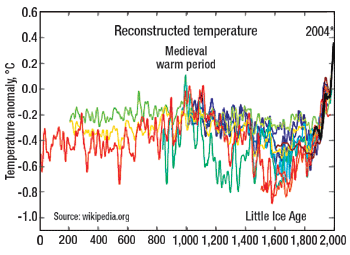A very bad move. Despite the graph, this is not really about global warming. As I was writing last month’s column, two congressmen, Joe Barton (R-Texas) and Edward Whitfield (R-Kentucky) decided to flex their political muscle and launched a volley against three scientists for, well, disagreeing with my President. Drs. Michael Mann, Ray Bradley and Malcolm Hughes authored a paper in 1998 that reconstructed the Earth’s temperature for the past 1,000 years. Stephen McIntyre, a semi-retired Toronto minerals consultant, began asking the lead author, as well as other researchers on the topic, questions about methodology, computer algorithms and more. McIntyre began working on his questioning full time, saying that he has spent much of his own money, plus foregone wages for more than a year. One researcher commented, “I am usually happy to send people some stuff, but he kept coming back time and again. He could take up a huge amount of time. It’s like you have nothing better to do in your life than answer questions from Stephen McIntyre.” McIntyre joined with fellow Canadian Ross McKitrick, an economist and global warming skeptic, to exhaustively investigate the Mann paper. At issue are a number of rather esoteric statistical methods that involve the use of principal component analysis, their weights, centers, and the effects of including or excluding certain data, such as bristlecone pine tree rings. The scientific consensus on global warming does not hinge on this one study. Elevating one or two temperature reconstructions to the false status of a climatic lynchpin, expressly for the purpose of knocking it down, is specious at best. I would guess that there are more than a hundred other graphs in the 2001 IPCC report, itself an edited compilation. There are many more scientists to chase than just Mann, Bradley and Hughes. In fact, there are at least 20 others that worked on 10 temperature reconstruction studies. These span the last 1,000 to 2,000 years, shown on the graph here as different colored lines. Mann, et al.’s 1998 study is the blue line, buried in the back. Removing it would change little. Other studies did not use Mann, et al.’s, methods or data; i.e., they were truly independent. This “spaghetti” graph, and others like it, clearly shows that there is no agreement as to methods and proxies for reconstructing temperature. However, if confined to the last 1,000 to 2,000 years or so, there is general agreement. There are many other studies that span 25, 150, 12,000, 450,000, 5 million and 500 million years.
Congressman Barton is Chair of the House Energy and Commerce Committee. He and Whitfield sent letters to Mann, Bradley and Hughes. They cited the WSJ article and two peer-reviewed articles published by McIntyre and McKitrick. Had the politicians stopped at asking questions about one or two studies, the request might have been reasonable. But they asked for everything and anything; in effect, a thorough documentation of the scientists’ life’s work. They were to put their lives on hold and begin digging out 15 to 30 years of research and computer code. They had 18 days. In making this extreme request, complete with the power of law, they made it clear their intent was to intimidate. Bradley said, “... it’s impossible. It would shut me down, which is what they want.” Even McKitrick said that he could not have complied with the kind of detailed request that Barton had sent. “...at the very least, I’d ask for a long extension.” By casting doubt on the credibility of this one study, the anti-climate alarmists have created the milieu of stench on the entire global warming issue, as was their intent. But after all of the questions are asked and answered, there is a good possibility that the curve of Mann, et al., will actually be more scientifically robust. That is because the attack is focused on the statistical methodology and underlying uncertainty in the data. But gathering more data and using state-of-the-art algorithms does not ensure a different outcome. Should this study hold up to further scrutiny, you can bet that it will be forgotten. There has been an outpouring of dismay against the politicians, and support for the scientists under attack. In a letter to Barton, Congressman Sherwood Boehlert (R-New York), chair of the House Committee on Science, called the investigation “...misguided and illegitimate. The only conceivable explanation for the investigation is to attempt to intimidate.” The American Association for the Advancement of Science and the National Academies of Science have also written letters to Barton. Through McIntyre and McKitrick’s efforts, a more rigorous process for computing paleotemperatures, and certainly for keeping good records, might well be the result. But the State has no business harassing scientists to achieve political ends, although, like temperature, that behavior also lies well within the past behavior of governments. Remember Galileo and Bruno? The first was shackled and spurned, and the last was burned. Not that these guys are Galileo, but the abuse of State power is similar. Barton also sent a letter to the National Science Foundation, requesting information on the work of Mann, et al., and a list of all NSF grants and awards in the area of climate research, which number over 2,700 in the past 10 years. These politicians have been clear: It’s akin to pulling the plug on stem cell research funding. Let’s face it. Americans don’t need scientists who want to research such things. Let them move to Canada, Europe or elsewhere to do their research. And all of the climate scientists can follow them.
|
|||||||||
- Prices and governmental policies combine to stymie Canadian upstream growth (February 2024)
- U.S. producing gas wells increase despite low prices (February 2024)
- U.S. drilling: More of the same expected (February 2024)
- U.S. oil and natural gas production hits record highs (February 2024)
- U.S. upstream muddles along, with an eye toward 2024 (September 2023)
- Canada's upstream soldiers on despite governmental interference (September 2023)





